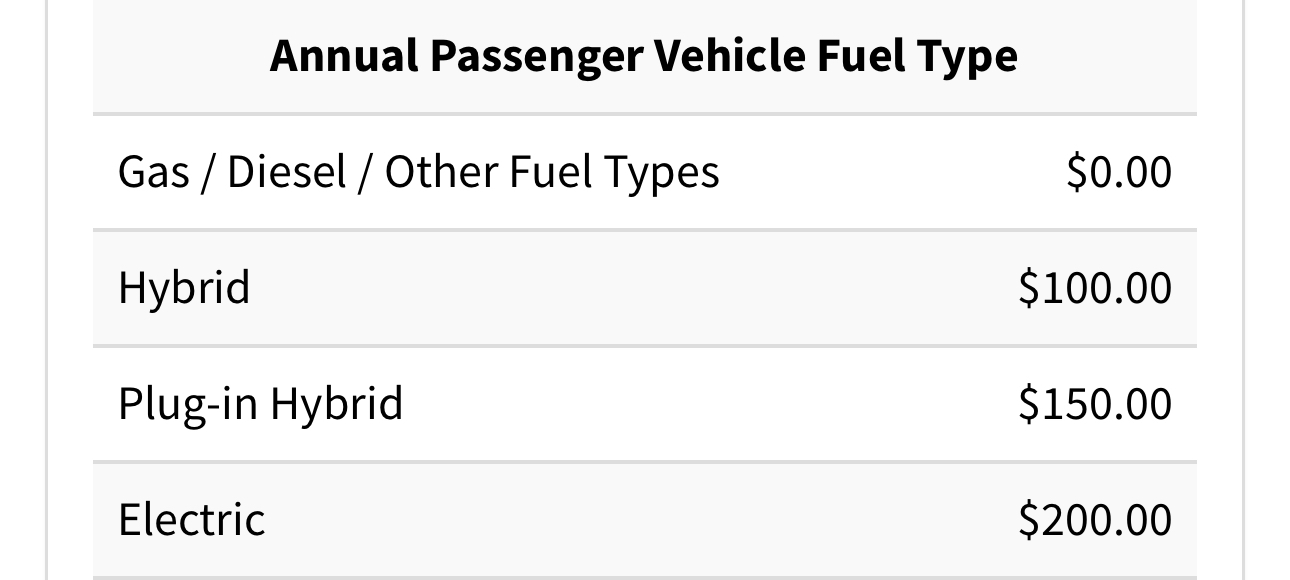

- cross-posted to:
- politics@lemmy.world




The new standards require American automakers to increase fuel economy so that, across their product lines, their passenger vehicles would average 65 miles per gallon by 2031, up from 48.7 miles today. The average mileage for light trucks, including pickup trucks and sport utility vehicles, would have to reach 45 miles per gallon, up from 35.1 miles per gallon. Selling electric vehicles and hybrids would help bring up the average mileage per gallon across their product lines.
Need to ditch the stupid distinction between trucks and passenger cars.
In many different areas. This is the per year registration fees in Ohio.  These fees are meant to compensate for road damage, which is calculated based on vehicle weight. Except Ohio just said “well batteries are heavy, charge them.”
These fees are meant to compensate for road damage, which is calculated based on vehicle weight. Except Ohio just said “well batteries are heavy, charge them.”
A lifted diesel super duty getting 12mpg will run you 0 dollars and 0 cents whereas even a plug in hybrid runs 150$ per year. Completely independent from the weight of the vehicle.
Biden can do what he wants but conservative states will constantly delay the transition to EVs, slowing adoption, infrastructure and the publics willingness at every opportunity.
It’s also supposed to make up for lost tax revenue on fuel, which would (theoretically) go to road maintenance.
That’s the real reason. They collect plenty of tax from the gas pumps, so they needed another way. The other option would be toll roads, which I haven’t seen here in Ohio.
That lifted diesel super duty getting 12mpg will get the state $0.47 in tax per gallon of diesel. If I did the math correctly that’s $391.67 per 10,000 miles. That’s about a years worth of driving for most people.
I’m so happy my 4000 miles last year cost me upfront half of what they pay gradually over a year. And yet the roads are still mediocre.
Okay, anyway, maybe someday they’ll increase the gas tax.
The fees should be floor(2*(vehicle weight in thousands of pounds)^3).
That would encourage lighter weight vehicles and be powertrain agonistic.
EDIT: I made an oopsie, meant thousands of pounds rather than pounds.
Am I doing the math right on this? Assuming your unit of fee is pennies: a 2600 lb bmw i3 (one of the smallest evs on the US market) would cost $351.5 million dollars to register. Even my 40 lb bike, if it was charged, would cost $1280. I’m all about car ownership being more expensive, but this seems…extreme
Oops, I did the math wrong. I meant in thousands of pounds.
Why would you assume the fee unit is pennies? I assume you’d scale all of these values proportionally to the revenue needs. I think the road damage formula was to the fourth power of weight, not third though.
Because it was the smallest unit of currency and the comment said the fees “should be” not “should be scaled by” or something to that effect. I first assumed it was dollars, but used pennies when it was obviously going to be too large. Idk, I guess that is where I went wrong, but it seemed like a reasonable assumption to make at the time that the formula was expressed in some denomination of currency
The standards will also require heavy-duty pickup trucks, such as the Chevrolet Silverado 2500 HD, and large vans, such as Amazon delivery vans, to reach 35 miles per gallon by 2035, up from 18.8 miles per gallon today
This is a step in the right direction, but it would be better if the standards for passenger cars would include all consumer vehicles.
A step in the right direction, but it should be even higher. The car industry should be complaining about it, not happily agreeing to it.
All that aside, we also should start priorizing the many other ways of getting around cities and states that don’t rely on cars and planes so much.
Bullet trains, crashproof bike lanes, and wide pedestrian paths should take priority. Give people options, and it makes life way easier.
Thats super optimistic /s
deleted by creator